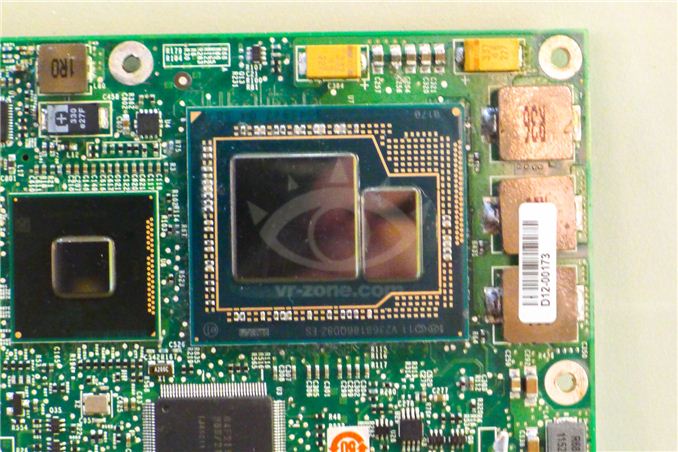Haswell GT3e Pictured, Coming to Desktops (R-SKU) & Notebooks
by Anand Lal Shimpi on April 10, 2013 7:21 PM EST
One of the worst kept secrets is Haswell will have four different GPU configurations: GT1, GT2, GT3 and GT3e. As with Sandy Bridge and Ivy Bridge, higher numbers mean more execution units, with GT3 topping out at 40 EUs. The lowercase e denotes an embedded DRAM part, with some amount of DRAM on the Haswell package itself (not on-die).
In an awesome scoop, the folks at VR-Zone managed to snag a photo of what looks like a quad-core Haswell die with GT3e graphics. The small package to the left should be the Lynx Point chipset (8-series), while the dual-die package on the right is Haswell + DRAM. The big square die should be Haswell itself with its 40 EU GPU, while the smaller die is the DRAM itself.
Intel hasn't officially acknowledged the existence of GT3e, but it did demonstrate performance of the part at CES earlier this year - targeting somewhere around the speed of NVIDIA's GeForce GT 650M. The DRAM size, operating frequency and bus width are all unknown at this point. I've heard the DRAM itself should be relatively small (~128MB), looking at the chip shot we get some indication but there's no confirmation of the specific type of memory we're looking at here (which obviously impacts die area).
Haswell GT3e will be available both in notebooks and desktops, however neither will come in socketed form (BGA-only). The desktop parts will carry an R suffix. This will be the beginning of Intel's socketed/soldered strategy on the desktop, which as of now is set to work sort of like tick tock - with the first chips on any new process being sold exclusively in BGA packages. Haswell will have socketed desktop SKUs, Broadwell won't, Skylake will, etc...
GT3e use in notebooks will be limited to larger designs it seems. Don't expect to find this level of graphics performance in a low wattage Ultrabook part, but it will likely surface in bigger notebooks - perhaps those driving ultra high resolution panels.
Source: VR Zone










64 Comments
View All Comments
TheFuzz77 - Wednesday, April 10, 2013 - link
Anyone know why Intel is moving to the socketed/non model?tipoo - Wednesday, April 10, 2013 - link
Saves a few pennies per motherboard/CPU for the tradeoff of what a relatively tiny minority of PC users do.Guspaz - Wednesday, April 10, 2013 - link
Saves some money/space, simplifies cooling (you can do permanently installed heatsinks and such), increases reliability, and because there's not much demand for socketed processors. Very few people ever upgrade a CPU, only enthusiasts, really. It sucks for those of us who ARE enthusiasts, but in the grand scheme of things, it won't have much (if any) of a negative impact.stickmansam - Wednesday, April 10, 2013 - link
Bigger issue is an dead MB taking your perfectly good CPU with it. Not that much of an issue if you can RMA, but once outisde of warranty, your $100-300mb can take out your $100-700 CPU (depending on your cpu, i7e is expensive)Plimogz - Wednesday, April 10, 2013 - link
Once they keep on integrating more and more of what was previously on the motherboard into the die with the CPU, the complexity of what remains on-board will diminish accordingly. So at least motherboard failure rates should decrease as well.LauRoman - Wednesday, April 10, 2013 - link
Most mb failures i see start of with the soundcard or a usb controller dying. I can't ever see the analog part of the audio controller ever being integrated.stickmansam - Wednesday, April 10, 2013 - link
true, but then a dead CPU would take your mb out with it then :PI did recently upgrade 3 mbs running pentium 4's with decent chipsets to use C2D CPU's so upgrading is not unheard of
This is esp true with AMD more so than recent intel. 4 sockets for 5 tick/tocks is not good
Johnnyrock - Thursday, April 11, 2013 - link
There is another side to that. On one hand, changing sockets constantly really puts a hurt on the wallets of enthusiasts. On the other hand, keeping the same socket might limit how much you can improve the platform. Legacy is both an asset and a liability, after all.techdawg667 - Wednesday, April 10, 2013 - link
Intel said that when they switch to BGA, which is after Haswell anyways, they will keep the enthusiast line socketed and the lower end CPUs will go BGA. So enthusiasts won't have to worry and general consumers can save a few cents.Ktracho - Thursday, April 11, 2013 - link
I don't want to buy an $600 big-socket CPU that doesn't run any faster than a $300 smaller-socket CPU, just because I want the potential to upgrade the CPU or change motherboards but keep the CPU.